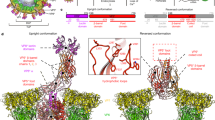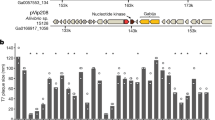Abstract
THE mechanisms whereby cytopathic viruses damage or kill susceptible cells are not fully understood. Some experiments with pox viruses involving partially inactivated virus or various metabolic inhibitors suggest a correlation between the production of virus proteins and the appearance of cytopathic effects without necessarily establishing a casual relationship between the two events1,2. Other work suggests that inhibition of host protein synthesis, and by extension induction of cytopathic effects by vaccinia virus, is independent of virus-induced protein synthesis but is some function of the virus particle itself3. Here, we report direct experiments in which vaccinia-specific materials were isolated from infected HeLa cells, rendered free from infective virus and shown to be toxic to susceptible uninfected HeLa cells under appropriate test conditions. To our knowledge this is the first documented example of an observable cell-killing effect of vaccinia specific protein(s). It differs from that of the penton capsomere (toxin) of adenovirus which affects cell membranes from the outside causing them to detach from glass4, in that we believe it acts intracellularly.
This is a preview of subscription content, access via your institution
Access options
Subscribe to this journal
Receive 51 print issues and online access
$199.00 per year
only $3.90 per issue
Buy this article
- Purchase on Springer Link
- Instant access to full article PDF
Prices may be subject to local taxes which are calculated during checkout
Similar content being viewed by others
References
Appleyard, G., Westwood, J. C. N., and Zwartouw, H. T., Virology, 18, 159–169 (1962).
Bablanian, R., Symp. Soc. gen. Microbiol., 22, 359–381 (1972).
Moss, B., J. Virol., 2, 1028–1037 (1968).
See Ref. 2 for references.
Birkbeck, T. H., and Stephen, J., J. gen. Virol., 8, 133–142 (1970).
Singh, L. M., Indian J. Exp. Biol., 10, 344–346 (1972).
Pagano, J. S., McCutchan, J. H., and Vaheri, A., J. Virol., 1, 891–7 (1967).
Ryser, H. J.-P., J. Cell Biol., 32, 737–750 (1967). Ryser, H. J.-P., Science, 159, 390–396 (1968).
Morfei, A., Popa, L., Burducea, O., and Portocala, R., Acta Virol., 13, 169–178 (1969).
Lucy, J. A., Nature, 227, 815–817 (1970).
Paton, C. R., and Allison, A. C., Nature, 227, 707–708 (1970).
Crook, N. E., Stephen, J., and Smith, H., Immunochemistry, 9, 945–960 (1972).
Nicklin, M. G., and Stephen, J., Immunochemistry, 11, 35–44 (1974).
Thacore, H., and Wolff, D. A., Nature, 218, 1063–1064 (1968).
Pagano, J. S., Prog. med. Virol., 12, 1–48 (1970).
Cordell-Steward, B., and Taylor, H. W., Proc. natn. Acad. Sci. U.S.A., 68, 1326–1330 (1971).
Nias, A. H. W., and Fox, M., Cell Tiss. Kinet., 4, 375–398 (1971).
Author information
Authors and Affiliations
Rights and permissions
About this article
Cite this article
STEPHEN, J., BIRKBECK, T., WOODWARD, C. et al. Vaccinia virus cytotoxin(s). Nature 250, 236–238 (1974). https://doi.org/10.1038/250236a0
Received:
Revised:
Issue Date:
DOI: https://doi.org/10.1038/250236a0
This article is cited by
-
Further studies on a vaccinia virus cytotoxin present in infected cell extracts: Identification as surface tubule monomer and possible mode of action
Archives of Virology (1979)
-
Vaccinia virus cytotoxin
Archives of Virology (1977)
Comments
By submitting a comment you agree to abide by our Terms and Community Guidelines. If you find something abusive or that does not comply with our terms or guidelines please flag it as inappropriate.



